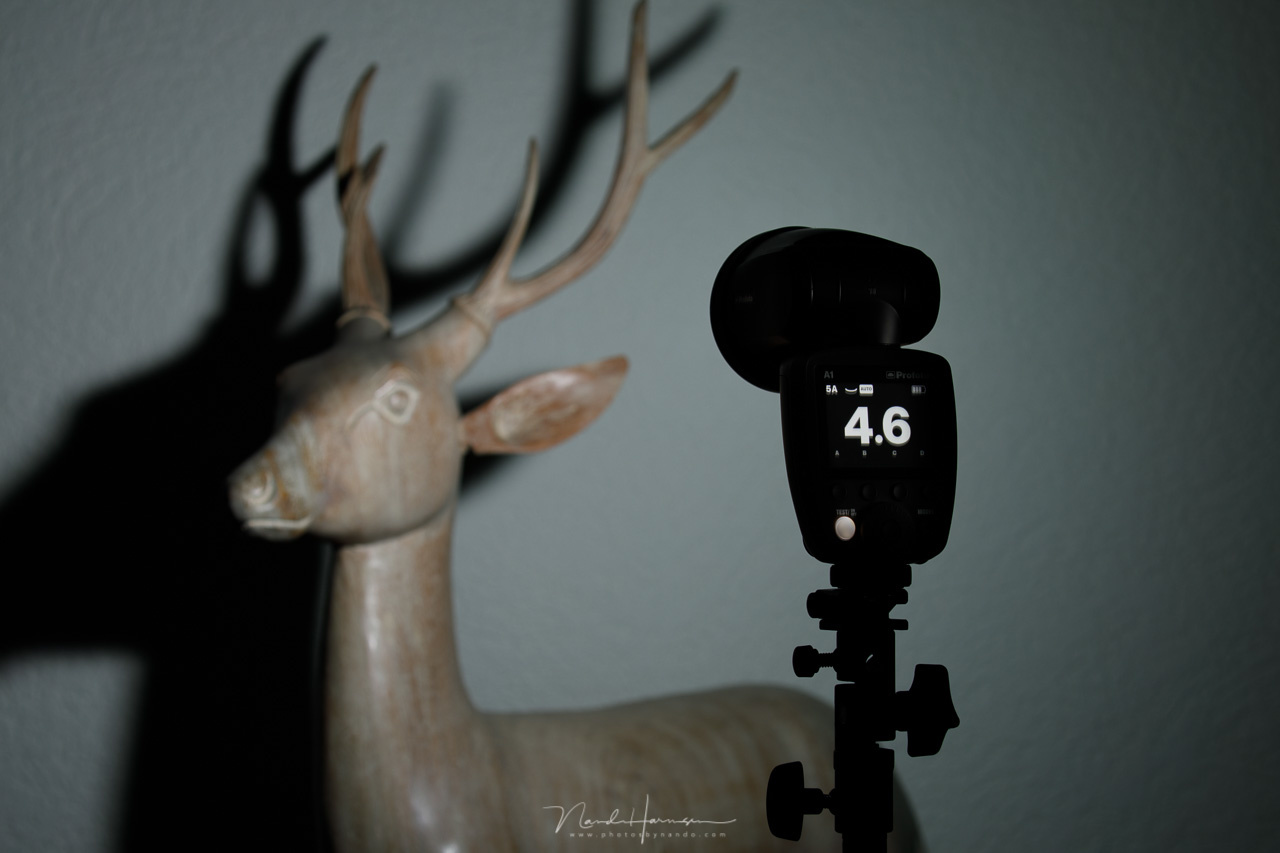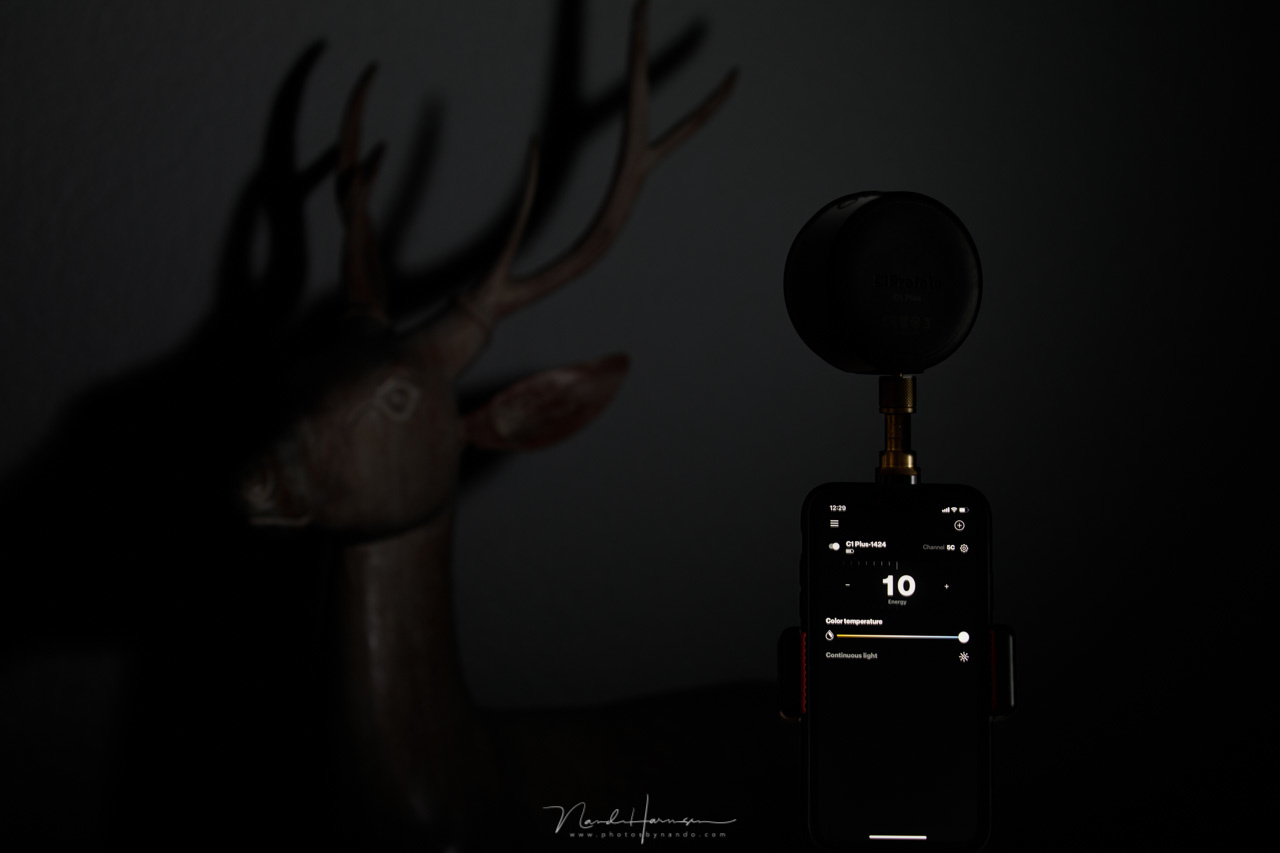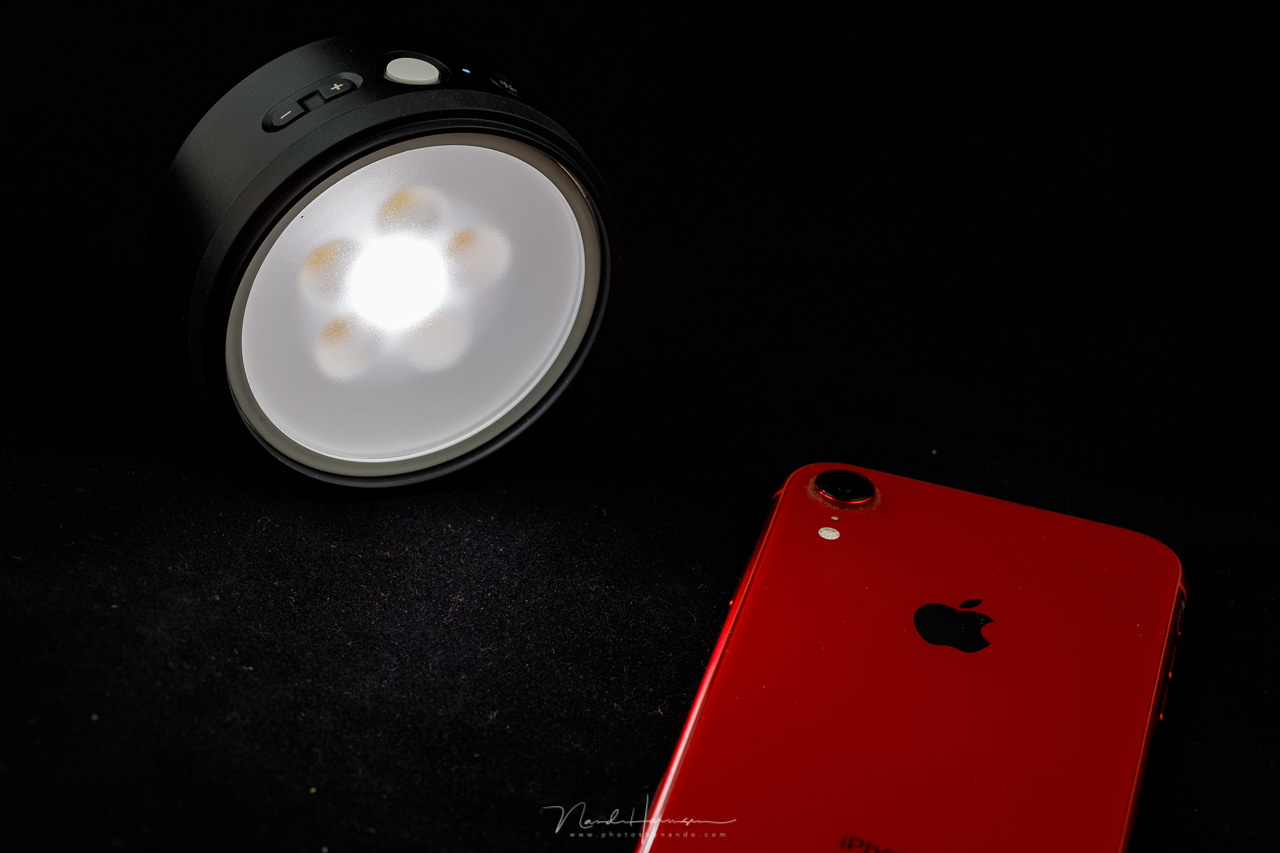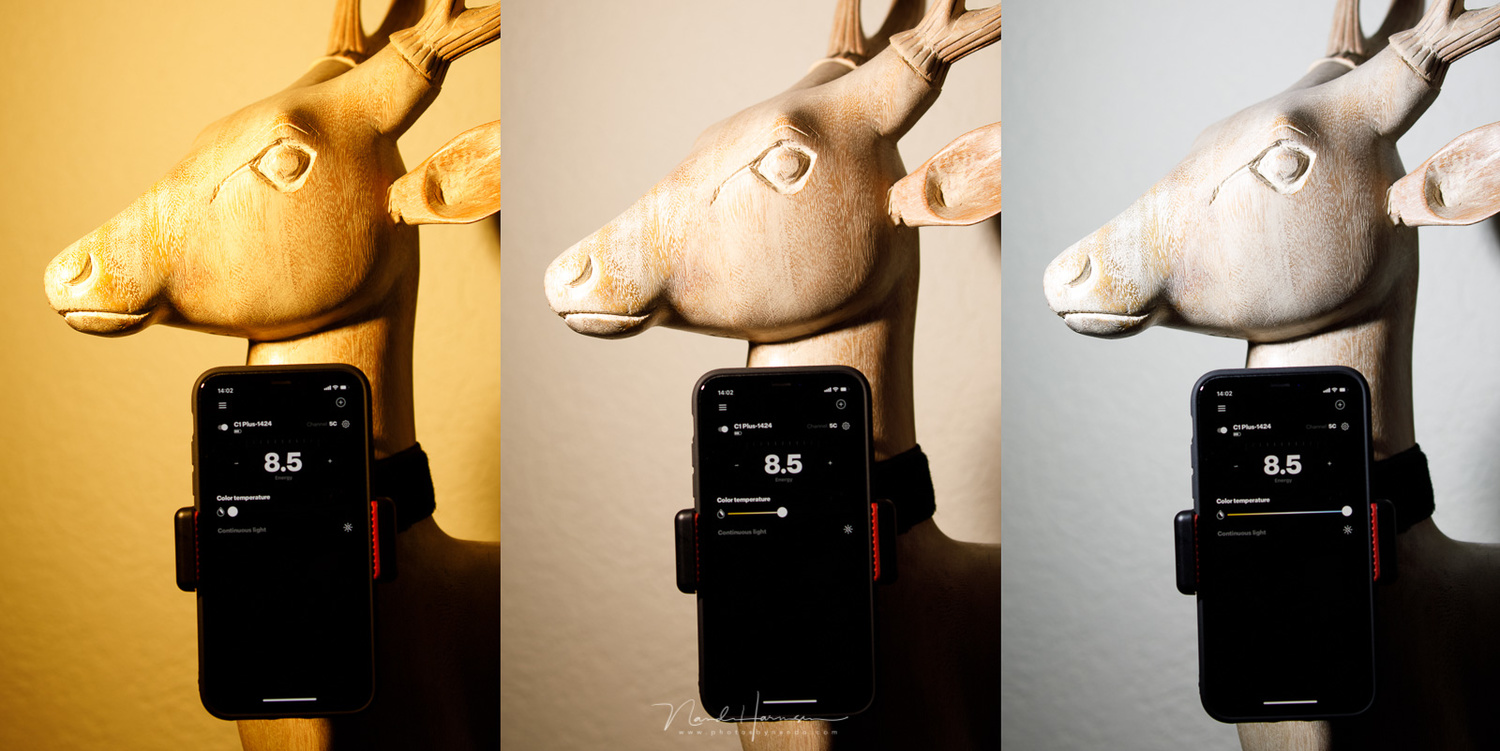Today there are a lot of photo enthusiasts that only use a smartphone. It is easy for a lot of people, placing content directly online. Wouldn’t it be great of there was a way to have a flash light that would work seamless with a smartphone? Profoto has the C1 and C1 Plus flash for that.
Something that is missing in smartphone photography is a decent light. The LED that are present in a smartphone are far from perfect for the job. Wouldn’t it be nice of there was a external flash light that could communicate with a smartphone, providing the possibility to shape the light anyway you like? Well, there is. It is called the Profoto C1 and C1 Plus, and as far as I know it is the first of its kind.
The Profoto C1 and C1 Plus are small flash lights that are designed for use with a smartphone. A modern iPhone, to be precise. It is using Bluetooth to communicate with the Profoto app, synchronizing the flash and the shutter. Or you can use the continues light, to see how the light shapes.
The C1 is the most simple version, requiring the app to change any settings. It only has a small button, that acts as the main switch, or shutter button. There is also a more advanced version, the C1 Plus. It provides the ability to change settings on the unit itself. And it has a build in Air Remote, making it able to work together with the remote flash system of Profoto. I got a change to try out the C1 Plus for some time.
Some Facts About the Profoto C1 Plus
The C1 Plus has a magnetic ring that can hold a number of flash accessories. It is standard provided with a removable dome, but you can also buy a set of grids and color gels. It is the same magnetic mount that can be found in the Profoto A1 and A1X flash lights, which is a good thing. The C1 Plus is also provided with a 1/4" tripod mount, something the C1 lacks.

The Profoto C1 Plus has only a basic set of buttons and one single connector. But it does have a tripod mount, fortunately.
Besides the Air Remote, the C1 Plus also has a button to switch on the continues light, and it has two buttons to change the flash/continues light intensity. Besides the tripod mount, the unit has a USB-C connection to charge the build in battery. That battery is good for 2000 full power flashes, or 40 minutes of continues light, which is impressive.
The build is very good, as expected from Profoto. The back is made of rubber and provides a good grip. The C1 Plus is just shy of 180 grams, and a little over 200 grams with dome. The diameter is 7.9 centimeter and fits in the palm of your hand.

The Profoto C1 Plus is small enough and fits right into your hand. The build is very good, and the rubber on the back gives it enough grip.
Power of Light
The light is provided by a set of five powerful LED, surrounding a single LED for the continues light. Profoto is mentioning 4300 lumens of light production by the flash, but since it does not mentioning any regular flash intensity numbers. This makes it difficult to compare the light output with a regular flash light. I have performed a simple test by comparing it to the Profoto A1 flash, just to have an idea how it performs.
I found a friendly deer that was willing act as a model, and I shot the animal with both the A1 and the C1 plus from about two feet away. I used ISO100 and f/8 and needed 4.6 stops of light from the A1 to end up with a acceptable exposure. The flash was triggered through the Air Remote.

With f/8 and ISO 100 this Profoto A1 flashgun produces a good exposure with this settings.The distance to the subject is about two feet.
Next I tried the C1 Plus with the same settings, using the small flash at full power. I ended up with a seriously underexposed image. I found out it resembled the lowest setting of my A1 flash light.
The C1 Plus produces about 8 to 10 stops less light than the a regular flash light, so it seems. Although the C1 Plus is usable in a Air Remote setup, the small flash is obviously not strong enough to play a significant role when used with larger studio or strobist lights. It is nothing more than a small flash light that produces a small amount of light also, perhaps enough for a bit of fill light from a close distance.

With f/8 and ISO100 the C1 Plus does not produce enough light for a proper exposure, not even with maximum output.
I tried to think of a better use for this small light, and I think it would be great for macro photography, where the flash can be placed at a very small distance. I did so when photographing some mushrooms in the forest, where the flash can produce that bit of extra light for your subject.
The Profoto App
Although the Profoto C1 Plus can be used in an Air Remote setup, it is mainly intended to be used with a smartphone. For that, Profoto has an app that only works with an iPhone. You need at least an iPhone 7 to be able to use the app.

You need an app to use the Profoto C1 Plus flash in a proper way. Unfortunately it is limited to iPhone users. If you have an Android smartphone, you cannot use the C1 Plus.
Without the app, you cannot use the C1 Plus to its full extent. It is the same app that also communicates with the wonderful Profoto B10 flashes.
When the C1 Plus flash is activated, the app will find the unit without any problems. Everything in the app speaks for itself, and you also have access to some tutorials, and payed academy videos. By making an account on the Profoto website, it is also possible to easily upgrade firmware, if necessary.

The Profoto app is very straight forward and easy to use. It also communicates with the Profoto B10 flash
The app also contains a camera function, that works seamless with the C1 Plus flash. Unfortunately the flash won’t work with any other camera app. You can shoot in JPEG format, JPEG with a DNG file, and the HEIF format.
The remote control inside the app makes it possible to change the intensity of the flash, and the continues light. It is also possible to change the color temperature of the light, ranging from 3000K up to 6500K, with a uncertainty of 200K.

The Profoto C1 Plus has the possibility to change the color temperature of the light, as seen in this example. It can only be changed from the app.
The camera inside the app is the perhaps most important function for working with the C1 Plus. This is the only way to use the flash together with the smartphone. Fortunately it allows you to change most settings, including shutter speed, ISO, and white balance. There is a self timer available.
The exposure is mentioned in an EV scale, ranging from 0EV up to 20EV. Although it seems strange at first, and completely different from the usual camera settings, it becomes a great way of reading the exposure. You just have to get used to it.
The camera can be used without flash, but it is designed to work with the C1 and C1 Plus. The flash and continues light intensity are also mentioned in stops.

Setting exposure with the camera function of the Profoto app. It read in exposure value (EV), something that requires some getting used to.
The app makes it possible to use more than one C1 or C1 Plus flash, as well as one or more B10 flashlights. Every flash can be set individually from the app.
Camera and Flash Exposure Settings
The flash unit and the app work quite well. But how does that translate to use in real life with a smartphone?
For that you need to hold the flash unit in one hand, and the smartphone in the other hand. In other words; you need two hands. This is no problem when everything is in auto settings, but when used in manual mode, you really need another hand to operate your app.

Since you have both the smartphone and the Profoto C1 Plus in your hand, changing settings can be more difficult. You need an extra hand for that.
It is difficult to change settings on the smartphone with one hand, so I needed to use the hand with the flash for that. In other words, there was almost no way to keep the flash at the exact same location when I also wanted to change settings. Fortunately the C1 Plus does have the possibility to change flash intensity from the unit. And the white button on the unit will act as a shutter release button, which is quite convenient.
Photographing in the automatic mode is very flexible with the C1 Plus. By setting the flash power, the exposure of the camera will be adjusted accordingly. This way it is possible to change the appearance of the photo. A low flash setting will blend the flashlight with the ambient exposure, producing a natural looking photo. A high flash setting will make the flash light more dominant, suppressing the ambient light to some extent. The end result will look much more dramatic.

When exposure set in auto, the Profoto C1 Plus works the best. By changing the flash power, you can determine how much ambient light will be recorded. Profoto calls it a natural looking photo, and a dramatic looking photo.
Using the flash in manual mode, it will be necessary to set the camera exposure as well, making it much more difficult to acquire a good exposure. As far as I know it is not possible to use manual camera exposure together with a real TTL like flash exposure.
Real Life Use of the Profoto C1 Plus Flash
I have not used the flash in an Air Remote setup, only with smartphone photography. I tried to use the flash unit during a poster session at an university, shooting with a smartphone while holding the flash in different positions. The results were acceptable, and although Profoto mentioned the flash as a professional flash for smartphone photography, using a smartphone during a paid reportage does not look that professional.

University students during a poster presentation, shot with a smartphone and lit by the Profoto C1 Plus. It does not feel right, taking photos with a smartphone under these circumstances. It does not feel professional, even with the Profoto flash unit in your hand.
I also used the flash while photographing mushrooms in a forest, with all the time in the world and a really small tripod. This way I could leave the flash unit at a fixed location while changing settings, transforming it in a strobist mushroom session. In this way the C1 Plus worked very well.

Photographing in a more relaxed situation, with time to change settings if needed. I used a orange color gel on the Profoto C1 Plus
A Careful Conclusion
Finding out how this little C1 Plus flash light works, wasn’t that easy. But when I did, I enjoyed using it. The best way of using the C1 Plus is with the automatic camera settings, changing flash intensity to give the photo the looks you want. When using in manual mode, you need a tripod to keep the flash unit in the right position. Otherwise you need another hand.

This is how I took the previous photo. The Profoto C1 Plus works very well together with the smartphone, but you have your hand full when using it without a small tripod.(credit: Hetwie (http://www.hetwie.nl))
Because the flash is that small, the light source is also small. This leads to harsh light, even with the dome in place. This will be especially visible when using the flash in the dramatic setup. Flash modifiers, like soft boxes and umbrellas, to shape the light in a professional way, won't work. The amount of light these units produce is simply not enough for that.
I don’t think these flash units are suitable for professional use, although the creative photographer can find some use for it in his or her light setup. For macro photography it can work wonderfully. This flash is small, and easy to take with you. Because of its limited maximum flash intensity it is perfect for small distances. Keep in mind, you need the app for a full control of the unit.
Strengths of the Profoto C1 Plus
- Very well built
- Works well with the Profoto app
- Magnetic ring for accessories
- Accessories interchangeable with the Profoto A1 and A1X flashlights
- Tripod connection
- Power button is a shutter release button also
- A continuous light button present
- Flash intensity can be regulated from the flash unit
- Color temperature of the light can be changed
- Up to 2000 full power flashes, or 40 minutes continuous light
- Small, compact, and very light
- It's very easy to use with automatic camera settings
- Air Remote build in
Weaknesses of the Profoto C1 Plus
- Very high price
- The app only works on iPhone 7 or newer models
- Flash intensity is not that impressive
- It does not work the same as a regular flash
- Not easy to use manually – ideally you need a third hand
- Only works with the camera function of the Profoto app
- Limited use as an extra flash in Air Remote setup with larger flashes
- Even with Air Remote you need the app to change settings
- It takes about 2 seconds before a photo with flash is made, due to light measurements
The question remains: is it worth the high price? That is a question that is not easy to answer, since it is mainly for smartphone users that take smartphone photography seriously. It is clearly a wonderful thing, that can bring light in dark places.
It is possible to use the flash as a fill light for portraits, but not more than that. It can be used to shape light for things like food photography, to name one example. In other words, for subjects that are reasonably close by. I have found out it works very well with macro photography, even when you use a regular DSLR or mirrorless camera for that. But you still have to own a Profoto Air Remote. Using the C1 Plus in a normal studio or strobist setup is not practical due to the limited amount of flash power.
Is it worth the price? Well, if you spend more than a thousand Euros for an iPhone, perhaps it is. But you are the only one that can make that decision.
What do you think of this great little flash light? Is it something you would consider if you were (or are) shooting with a smartphone?Please let me know in the comments below.












.
Why not?
Only $500? 😉
Even less. 499
hahaha ;)
The Godox A1 can currently be had for under $60, which lets you do an eight light setup for less money.
Godox app is horrible, not worth anything
Does it have have 2times more output than those portable video lights which are sold for 150$ so ?
I cannot answer that question, unfortunately. I simply don't know.
Looks the like max output of the C1 is roughly 0.3 watts. If the profoto A1 is 76w at power level 10, that makes it 0.3 watts at power level 2, which appears to be the equivelant of the C1 at max power.. Not much light.